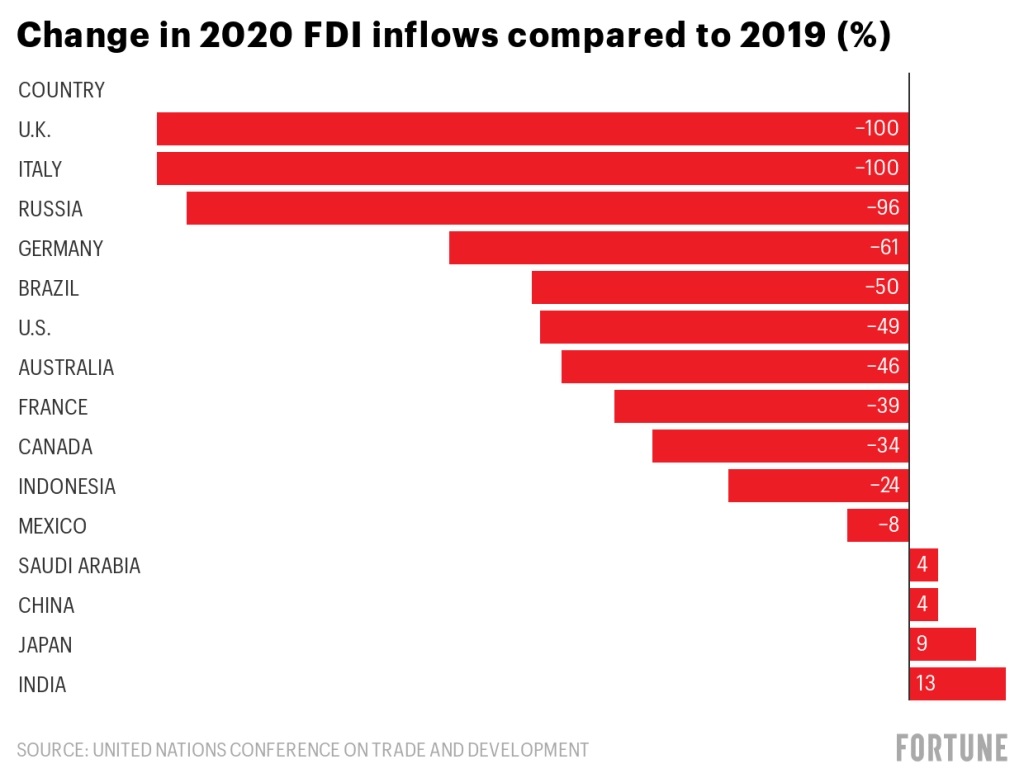联合国贸易和发展会议称,印度外国直接投资在2020年同比跃升了13%,也让其成为了全球主要经济体中外国直接投资领域出现增长的少数几个国家之一。
2020年上半年,由于印度经济活动因全国范围的封锁而陷入停滞,其外国投资一直在低位徘徊,但却在8月份出现激增,这在很大程度上归功于科技巨头Jio Platforms获得的股本注入。Jio Platforms是Reliance Industries旗下公司,而后者是印度首富穆科什·安巴尼经营的集团企业。
Jio Platforms从Facebook和谷歌那里分别获得了57亿美元和45亿美元的投资,并从多家购买Jio股权的美国私募股权公司那里获得了小规模注资。Jio涉足的领域包括电信、电商和云计算等。
印度国家应用经济研究委员会研究印度外国直接投资的高级研究员普乐米拉·那扎勒斯·萨特延南德说:“印度外国直接投资增长的另一个原因在于,新冠疫情并没有影响,反而进一步推动了此类数字经济投资,并大幅提升了其盈利潜力。”
联合国贸易和发展会议表称,Facebook耗费57亿美元购买了Jio 10%的股份,占到了印度2020年跨境并购交易总额的21%。
就在8月外国直接投资激增的同时,印度整体经济也在缓慢地恢复。印度GDP在截至6月的第二季度同比下滑了近24%,在截至9月的第三季度收缩了7.5%。
联合国贸易和发展会议称,全球外国直接投资去年的降幅达42%。流向美国、英国和其他主要经济体的外国直接投资均出现了下滑。印度、中国、日本和沙特是2020年外国直接投资出现增长的少数几个G20国家。
印度国家应用经济研究委员会高级研究员博纳莉·班达里称,Jio投资帮助推高了去年的外国直接投资总量,但整体来看,流入印度的外国直接投资依然专注于服务、IT和电信领域。她说:“我们需要开展更多的工作,让外国直接投资领域更加多元化。”
印度vs. 中国
联合国贸易和发展会议报告称,印度外国直接投资增长了13%,中国增长了4%。
尽管印度的增幅更高,但流入两国的外资额度却有着巨大差距。印度2020年获得的外国直接投资增长了570亿美元,而中国吸引的外资预估高达1630亿美元,比全球任何国家都要高。

印度的外国直接投资存量,也就是直接投资该国企业的外国资本总额,大大低于中国。
雷丁大学研究外国投资的国际商业法规教授拉吉尼什·那鲁拉说:“虽然印度的外国直接投资增幅达到了13%,但其基数较低。”
那鲁拉指出,印度的外国直接投资存量只有中国大陆的约三分之一,但两个国家的人口相当,都在14亿左右。印度的外国直接投资存量亦只有香港的三分之一,但后者的人口只有印度的约0.5%。
那鲁拉说:“对于一个像印度这样的国家来说,其外国直接投资存量不应只是香港的三分之一。因此这也说明,印度推销自己的举措基本上没有取得什么效果。”
不确定性原理
那鲁拉认为,印度外国直接投资存量之所以较低,原因在于长年累月的政治动荡,以及“声名狼藉”的政府行为——频繁更改外国直接投资法规,这些让外国投资者对于在印度投资感到毫无把握。
路透社上周的报道显示,印度政府正在考虑修订其电商领域的外国直接投资法规,但此举有可能会伤害像亚马逊这样的外国公司,而亚马逊间接持有印度电商公司Cloudtail和Appario的股权。
与此同时那鲁拉指出,投资者依然在积极地寻找进入印度的方式。“不管怎么说,它是全球最大的市场,总会有公司希望在印度市场出售其产品。”
就人口数量而言,中国当前是全球最大的市场,但印度的人口有望在2026年超过中国。
那鲁拉说:“各大公司认识到印度有13亿人口……这些公司希望在这一市场中占有一席之地。”
例如上周,石油跨国公司道达尔向印度可再生能源公司Adani Green Energy注资25亿美元,后者是Adani Group集团子公司。
与此同时,那鲁拉说,13%的外国直接投资增幅掩饰了疫情对全球经济和印度经济的不利影响。
“小公司一个个都勒紧了裤腰带,蛰伏在本国,因此我们在印度看到……大公司都在豪赌未来十年的发展路线,” 那鲁拉说,“事实上,正面的新闻少之又少,所有企业都推迟了大投资。大公司进行收购的原因在于,在开发长线业务方面他们并不差钱。”(财富中文网)
译者:冯丰
审校:夏林
联合国贸易和发展会议称,印度外国直接投资在2020年同比跃升了13%,也让其成为了全球主要经济体中外国直接投资领域出现增长的少数几个国家之一。
2020年上半年,由于印度经济活动因全国范围的封锁而陷入停滞,其外国投资一直在低位徘徊,但却在8月份出现激增,这在很大程度上归功于科技巨头Jio Platforms获得的股本注入。Jio Platforms是Reliance Industries旗下公司,而后者是印度首富穆科什·安巴尼经营的集团企业。
Jio Platforms从Facebook和谷歌那里分别获得了57亿美元和45亿美元的投资,并从多家购买Jio股权的美国私募股权公司那里获得了小规模注资。Jio涉足的领域包括电信、电商和云计算等。
印度国家应用经济研究委员会研究印度外国直接投资的高级研究员普乐米拉·那扎勒斯·萨特延南德说:“印度外国直接投资增长的另一个原因在于,新冠疫情并没有影响,反而进一步推动了此类数字经济投资,并大幅提升了其盈利潜力。”
联合国贸易和发展会议表称,Facebook耗费57亿美元购买了Jio 10%的股份,占到了印度2020年跨境并购交易总额的21%。
就在8月外国直接投资激增的同时,印度整体经济也在缓慢地恢复。印度GDP在截至6月的第二季度同比下滑了近24%,在截至9月的第三季度收缩了7.5%。
联合国贸易和发展会议称,全球外国直接投资去年的降幅达42%。流向美国、英国和其他主要经济体的外国直接投资均出现了下滑。印度、中国、日本和沙特是2020年外国直接投资出现增长的少数几个G20国家。
印度国家应用经济研究委员会高级研究员博纳莉·班达里称,Jio投资帮助推高了去年的外国直接投资总量,但整体来看,流入印度的外国直接投资依然专注于服务、IT和电信领域。她说:“我们需要开展更多的工作,让外国直接投资领域更加多元化。”
印度vs. 中国
联合国贸易和发展会议报告称,印度外国直接投资增长了13%,中国增长了4%。
尽管印度的增幅更高,但流入两国的外资额度却有着巨大差距。印度2020年获得的外国直接投资增长了570亿美元,而中国吸引的外资预估高达1630亿美元,比全球任何国家都要高。
印度的外国直接投资存量,也就是直接投资该国企业的外国资本总额,大大低于中国。
雷丁大学研究外国投资的国际商业法规教授拉吉尼什·那鲁拉说:“虽然印度的外国直接投资增幅达到了13%,但其基数较低。”
那鲁拉指出,印度的外国直接投资存量只有中国大陆的约三分之一,但两个国家的人口相当,都在14亿左右。印度的外国直接投资存量亦只有香港的三分之一,但后者的人口只有印度的约0.5%。
那鲁拉说:“对于一个像印度这样的国家来说,其外国直接投资存量不应只是香港的三分之一。因此这也说明,印度推销自己的举措基本上没有取得什么效果。”
不确定性原理
那鲁拉认为,印度外国直接投资存量之所以较低,原因在于长年累月的政治动荡,以及“声名狼藉”的政府行为——频繁更改外国直接投资法规,这些让外国投资者对于在印度投资感到毫无把握。
路透社上周的报道显示,印度政府正在考虑修订其电商领域的外国直接投资法规,但此举有可能会伤害像亚马逊这样的外国公司,而亚马逊间接持有印度电商公司Cloudtail和Appario的股权。
与此同时那鲁拉指出,投资者依然在积极地寻找进入印度的方式。“不管怎么说,它是全球最大的市场,总会有公司希望在印度市场出售其产品。”
就人口数量而言,中国当前是全球最大的市场,但印度的人口有望在2026年超过中国。
那鲁拉说:“各大公司认识到印度有13亿人口……这些公司希望在这一市场中占有一席之地。”
例如上周,石油跨国公司道达尔向印度可再生能源公司Adani Green Energy注资25亿美元,后者是Adani Group集团子公司。
与此同时,那鲁拉说,13%的外国直接投资增幅掩饰了疫情对全球经济和印度经济的不利影响。
“小公司一个个都勒紧了裤腰带,蛰伏在本国,因此我们在印度看到……大公司都在豪赌未来十年的发展路线,” 那鲁拉说,“事实上,正面的新闻少之又少,所有企业都推迟了大投资。大公司进行收购的原因在于,在开发长线业务方面他们并不差钱。”(财富中文网)
译者:冯丰
审校:夏林
Foreign direct investment in India jumped 13% in 2020 compared to the year before, making it one of the only major economies in the world to record an increase in FDI in the pandemic-battered year, according to the United Nations Conference on Trade and Development.
After low levels of foreign investment in the first half of 2020, when economic activity stalled in India under a nationwide lockdown, FDI levels spiked in August, thanks in large part to equity inflows to tech giant Jio Platforms, a subsidiary of India's largest company, Reliance Industries, the conglomerate run by Mukesh Ambani, India's richest man.
Jio Platforms snagged a $5.7 billion investment from Facebook and a $4.5 billon investment from Google, as well as smaller investments from several U.S. private equity firms that purchased stakes in Jio, which operates in industries like telecoms, e-commerce, and cloud computing.
"Indian FDI also grew because COVID didn't impact, but rather further buoyed, such digital economy investments and made them even more potentially profitable," says Premila Nazareth Satyanand, a senior fellow at India's National Council of Applied Economic Research who researches FDI in India.
The $5.7 billion Facebook acquisition, which represents a 10% stake in Jio, made up 21% of all cross-border mergers and acquisitions sales in India in 2020, according to UNCTAD.
India's spike in FDI inflows in August, occurred alongside a slowly recovering broader economy. After contracting nearly 24% year-on-year in the quarter that ended in June, India's gross domestic product contracted 7.5% in the quarter that ended in September.
Globally, FDI dropped 42% last year. Inflows declined for the U.S., the U.K., and other major economies. India, China, Japan, and Saudi Arabia were the only G20 countries where FDI rose in 2020, according to UNCTAD.
The Jio investments helped drive up FDI last year, but overall, FDI into India is still concentrated on the services, IT, and telecoms sectors, says Bornali Bhandari, a senior fellow at the National Council of Applied Economic Research in India. "We need to do a lot more to make it more broad-based," she said.
India vs. China
India's FDI increased by 13%, while China's rose 4%, according to the UNCTAD report.
Despite India's higher increase in terms of percentage points, the amount of money flowing to the two countries differs enormously. India's FDI rose to $57 billion in 2020, while China attracted an estimated $163 billion, more than any other country in the world.
India's FDI stocks, the total value of foreign capital directly invested in the country's businesses, is also significantly lower than China's.
"The number has gone up by 13%, but it's a low base," says Rajneesh Narula, a professor of international business regulation at the University of Reading who researches foreign investment.
Narula pointed out that India's FDI stock is roughly a third of mainland China's, which both have a population of around 1.4 billion people. India's FDI stock is also a third of the FDI stock in Hong Kong, which has a population roughly 0.5% that of India's.
"For a country of that size it shouldn't be [one third] of Hong Kong, so it indicates...that India's efforts to sell itself have been largely unsuccessful," Narula says.
Uncertainty principle
Narula attributes India's low FDI stock to years of political tumult and "notorious" government changes to regulations on FDI that can leave foreign investors uncertain about putting money into India.
Reuters reported last week that India's government is considering revising FDI rules in e-commerce that could hurt foreign firms like Amazon, which owns indirect equity stakes in Indian e-commerce companies Cloudtail and Appario.
At the same time, Narula says, investors remain eager to find ways into India. "At the end of the day, it's the world's largest market...there's going to be people who want to sell in the Indian market."
China is currently the world's largest market by population size, but India's population is expected to overtake China's in 2026.
"Companies recognize there's 1.3 billion people [in India]...companies would like to get hold of this market," Narula says.
Last week, for instance, oil multinational Total SA invested $2.5 billion into Indian renewable energy firm Adani Green Energy, which is owned by the conglomerate Adani Group.
At the same time, Narula says the 13% FDI increase belies the extent of the pandemic's negative effect on the global economy and on India's economy.
"The smaller companies are all tightening their belts and staying at home, so what we're seeing in India...is large companies making large bets to think ten years down the line," Narula says. "The fact of the matter is there's very little positive news. Everyone's holding off on big investments. The big companies are making acquisitions because they can afford to play the long game."






